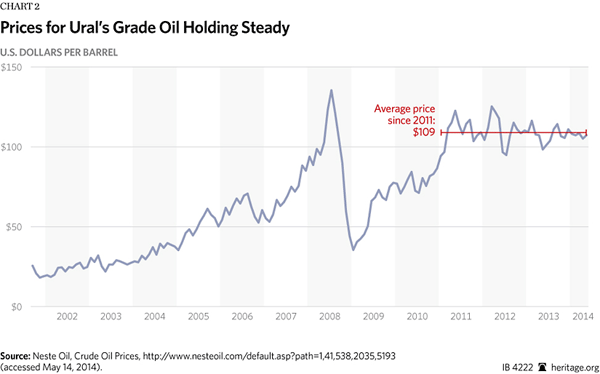For the Russian economy, winter has come early this year. After cruising at a respectable 3–4 percent rate of growth earlier this decade, Russia’s pace of expansion sharply decelerated toward the middle of 2012. According to Alexei Ulyukayev, the minster of economic development, the economy contracted for the first time since the 2008 recession during the first quarter of 2014.
While Russia’s geopolitical tensions are certainly adding to the downward spiral in growth—and with a recession likely in 2014—growth collapsed well before the Kremlin’s Ukraine debacle. With the possibility of additional economic sanctions against Russia, it is important to understand the actual cause of this slowdown and its longer-term consequences.

A Russian Riddle
Historically, just two things have driven Russia’s rate of economic expansion: the price and output of oil. The 7 percent rate of economic growth averaged last decade before the financial crisis and recession was powered by a seven-fold increase in oil prices. The subsequent crash in prices produced a whopping 8 percent contraction in real gross domestic product (GDP) growth in 2009, while the sharp rebound in prices early in the global recovery afforded the Russian economy growth of over 4 percent.[1]
This relationship between energy prices and growth has completely broken down over the past two years. From the beginning of 2011 until May 2014, the price of Ural’s grade oil has averaged $109 per barrel. Historically speaking, these are elevated prices, even after adjusting for inflation.
Nor was the culprit declining oil production, which remained strong over this period, averaging about 10.5 million barrels per day—very close to the post-Soviet highs.
Easy Credit, Capital Flight
So why is energy no longer the magic elixir for the Russian economy? Chart 3 provides a clue. Russia’s 3–4 percent rates of growth earlier in the decade were possible only because of strong consumer spending, which was financed by enormous growth in credit. After peaking in mid-2012 (precisely when the economy began to slow) at an atmospheric 43 percent clip, the growth in consumer credit began to decelerate. In short, economic growth was being driven by easy credit whose trajectory was not sustainable.

Without ever-rising energy prices or domestic credit, the Russian economy appears to have hit the classic middle-income trap: protracted slow growth brought on by the government’s complete lack of interest over the past decade in the sort of supply-side reforms that would increase domestic investment and productivity. Despite its endowment of oil, gas, and mineral riches, Russia has suffered for years from a dearth of private investment that could diversify its economy and cushion it against commodity-price fluctuations. Russia’s international sales of goods and services last year only barely edged out Belgium’s—and were positively dwarfed by the Netherlands.[2]
And it is no wonder why Russia is not attracting foreign capital. In the most recent survey from the International Finance Corporation’s and World Bank’s Doing Business survey, Russia was ranked 115 out of 189 countries, putting it on par with an average sub-Saharan country.
And capital continues flowing out of Russia. The European Central Bank, with confidential data, recently estimated that capital flight since the Ukrainian crisis erupted may be as high as 160 billion euros ($222 billion), four times higher than admitted by the Kremlin. This would be the same scale of outflows witnessed in late 2008 during the Lehman crisis. (Capital flight was estimated at $63 billion for all of 2013.[3]) As legendary American banker Walter Wriston once said, “Capital will go where it is welcomed and stay where it is well treated.”
The state’s control of the “commanding heights” has given it enormous degrees of corporate control in recent years. The energy sector is once again largely in state hands. Privatization plans continue to be delayed or scaled down, meaning that Russia’s most lucrative state-owned assets, such as oil firm Rosneft, are not on the privatization schedule and are unavailable to foreign investors. All these factors have made the Russian stock market the cheapest (in terms of price-earnings ratios) of any of the world’s major exchanges.
Energy Dependence
Not surprisingly, all of these factors have made Russia more energy dependent. The fiscal break-even price of oil needed to balance the Russian budget was $34 in 2007. Today it is $117. Russia gets about 70 percent of its export revenue from oil and gas, so even a modest drop would be a significant blow for the authorities and would force it to tap into its reserve fund. After running a budget surplus of almost 0.8 percent of GDP in 2011, Russia ran a fiscal deficit of 0.5 percent in 2013.
While Russia has one of the largest stashes of foreign exchange and gold reserves in the world—valued at approximately $500 billion—because its budget is so dependent upon energy exports to the West, these formidable reserves could quickly dissipate if oil fell to $80 a barrel or Europe were to stop buying Russian gas.
In for a Long Winter
Looking longer term, there is little room for enthusiasm. The demographic time bomb seems impossible to avoid, and the shale gas revolution is quickly spreading. Russia is the world’s most corrupt major economy.[4] As Russia’s ties with the West and its business climate deteriorate, Russia risks years of sluggish economic growth that could deepen its dependence on oil and gas and strengthen the state’s dominance of the economy. It is probably a good thing that Russians are accustomed to brutal winters, because this could be a long one.
—William T. Wilson, PhD, is Senior Research Fellow in the Asian Studies Center at The Heritage Foundation.
